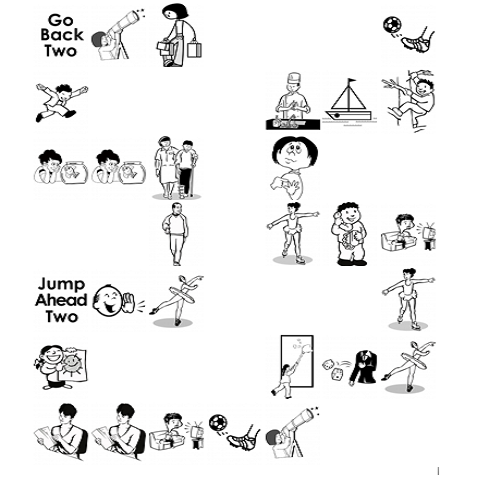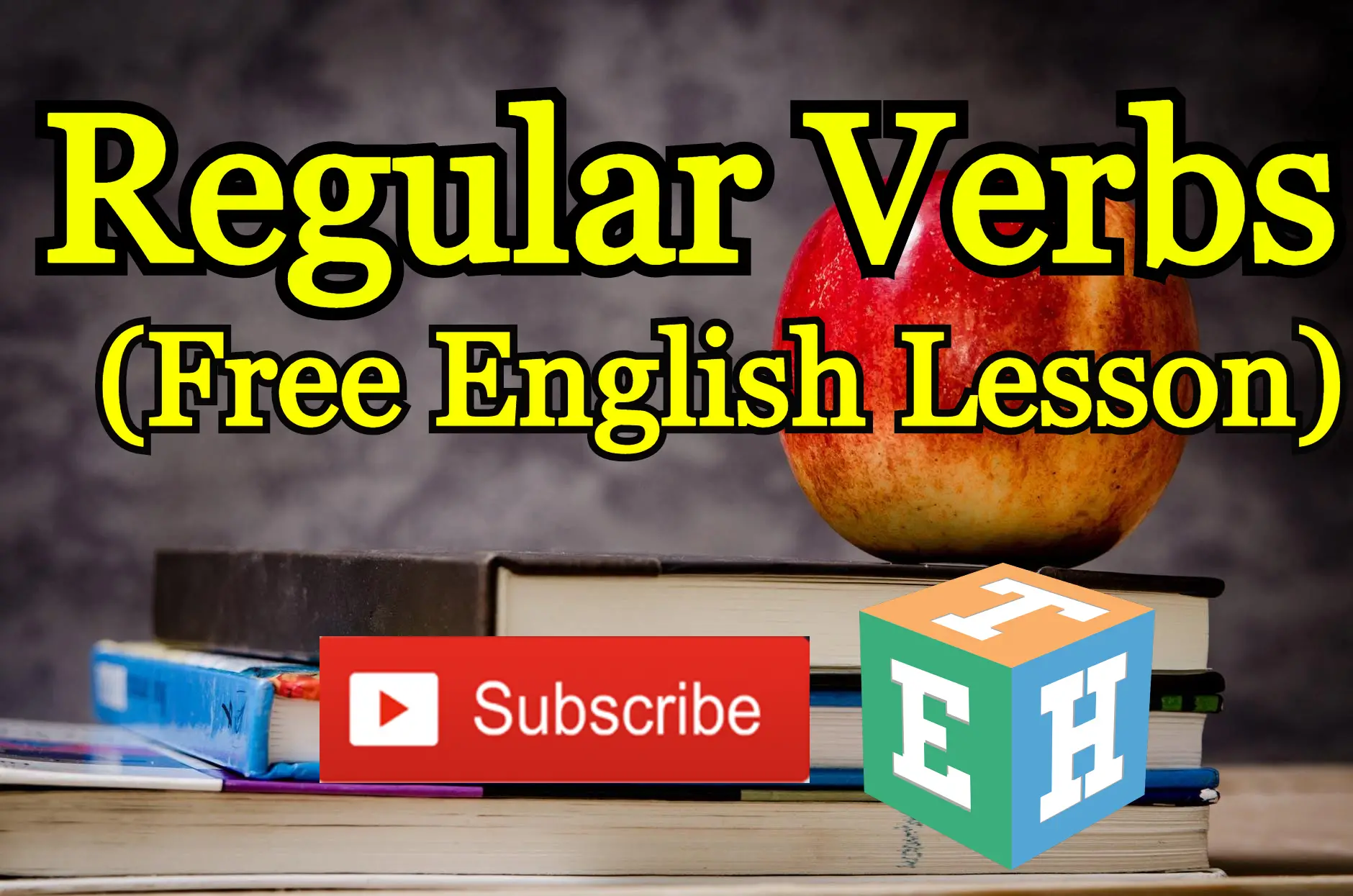Regular Verbs
In this phase of tutorial for beginners, learners are expected to recite, demonstrate, identify, and write “Regular Verbs”. What “Regular Verbs” defines?. What are the rules in forming “Regular Verbs”?.
In this lesson, you will increase your vocabulary and improve you writing skills of “Regular Verbs” that makes your sentences alive.
WB: Draw man’s face.
Elicit: Name? Henry
Age
Where from
Family etc . . .
‘Henry’s dead but he had a good life’.
H/O 1 Henry’s Life.
What’s missing? The dates.
Ss melee and copy dates from the walls:
1929, 1943, 1946, 1960, 1965,1966, 1988, 1988, 1988, 1998.
Drill: Use a picture representing each of the main events in Henry’s life.
Drill through his life (choral) and correct pronunciation
WB: Show life on timeline with dates. Elicit verbs onto timeline and highlight ‘-‘ed’ rule
-1929——-1943—————————————————now
Questions: Try to elicit questions from prompt
“start/school” – “when did Henry start school”
Highlight form Past simple questions
H/O 2 Make questions to ask about Henry
Ss complete using rule.
Running dict. Ss copy “wrong information sheet”
WB “Henry started school in 1926″ Correct? . . . No
Elicit: Henry didn’t start school in 1925, he started school in 1929
Highlight form Past simple negatives
Writing: Ss write more sentences from running dictation
Pron. /t/ /d/ /id/
worked died started
dictate verbs and Ss write down in columns:
liked played wanted washed
moved finished cooked visited
stayed retired died talked
waited worked lived started
Feedback onto WB
Rules : /t/ after k, sh, f, p, th
/d/ after v, n, y, ie, r, s, b, g, l, m, + vowels
/id/ after t, d,
Henry’s Life
1. Henry was born in 1923
2. He started school in _________
3. He finished school in ________
4. He joined the army in ___________
5. Henry’s brother moved to Australia in __________
6. Henry visited his brother in __________________
7. From ______ to _______Henry worked as a gardener.
8. In ______ Henry retired.
9. From ____ to ______ he lived in Manchester.
10. Henry died in 1998.
Make questions to ask about Henry.
1. When was Henry born?
2. When did Henry start school?
3. When _____Henry ________school?
4. When _____he ______the army?
5. Where _____his brother _______ in 1960?
6. When _____ he _______his brother?
7. When ______he _______ as a gardener?
8. What ______he ________ in 1988?
9. Where ______he ______ from 1988 to 1998?
10. When did Henry die?
What did you do yesterday? Regular verbs


Language Arts Lesson Plans Action Verbs Synonyms
Word Lesson Plan for Grammar and Parts of Speech
Learning grammar concepts like identifying action verbs and recognizing synonyms can be difficult for elementary students. This lesson plan offers creative ideas for presenting these concepts in an interactive fashion.
Literacy Lesson Plan Overview
This language arts lesson plan is geared to elementary grade students and can be taught in about 45 minutes. It can be used as a stand-alone lesson or in conjunction with other lessons to review and reinforce materials already taught.
The educational objectives for this lesson plan are:
- Reciting and demonstrating action verbs
- Identifying and writing synonyms for the action verbs
- Reviewing what verbs mean and verbalizing understanding
- Increasing vocabulary and improving writing skills
Learning and internalizing action verbs improves students’ writing skills by furnishing them with a broader vocabulary. This lesson plan is easy to teach and requires little pre-class preparation. The children hear a story, practice using action verbs and synonyms, and participate in a hands-on activity.
Classroom Lesson Plans Teaching Method
The supplies needed for this language arts lesson plan are minimal and inexpensive. The flashcards are prepared prior to the class and are the only pre-class prep needed.
Here is a supply list for this lesson plan:
- Duck, Duck, Goose, Tad Hills, [Schwartz & Wade Books, 2007]
- Flashcards for action verbs: shouted, yelled, called, hollered, whispered, leapt, screamed, exclaimed, groaned, moaned, interrupted, sighed, squawked, muffled, gurgle, pretended
- Flashcards for synonyms: Shouted – yelled, called, hollered, screamed, whispered – talked softly, leapt – jumped, exclaimed – cried out, groaned – moaned, interrupted – hindered, sighed – uttered, squawked – yelped, muffled – muted, gurgle – babble, pretended – imagined
- Construction paper
- Back issues of magazines
- Kid friendly scissors
- Glue
The teacher shows the book to the class and asks the children to look at the picture and predict what the story will be about. She points to the title, traces the words with her finger, and pronounces them. She repeats this process with the author’s name, and then instructs the class to listen for action verbs as she reads the story. The children are to touch their ear whenever they hear an action verb.
Literacy Lesson Questions and Activities
Here are some suggested discussion questions for this book. Because this is a language arts lesson, the questions are based on action verbs, but teachers can use other conversational questions if they choose.
- Duck shouts to Thistle and she yells back. What are the action verbs they use?
- Goose calls Thistle a little bird. What action verb does Thistle use when she answers?
- Goose asks Duck how long Thistle is staying. Use an action word to describe her tone of voice.
- Thistle asks Goose some math questions. Can you remember the action words that described how she spoke to Goose?
- What are some other words for shouting?
- Which one of the animals was the quietest?
- Who was the loudest?
Here are three vocabulary development and reinforcement activities to use with this lesson plan. One or all activities are used if time permits.
Prepare vocabulary cards for the action verbs and the synonyms. Hold up a flash card and point to the word, say the word, and trace the word with a finger. The children take turns calling out the synonyms.
Using the same flashcards, separate the action words. Each child chooses a card, and then acts out the action verb while the class tries to guess what the word is from watching the actions.
Let the children have free play time to work with the flashcards and match the action words with their synonyms. Hands-on activities like these help young children make the connection between the written and spoken word.
Language Arts Craft Activity and Lesson Extension
The teacher writes the list of action words on the whiteboard. The students use magazines and look for pictures or words to match them. They cut or tear out the words and pictures and glue them to the paper to form their personal action words list.
This lesson is extended by giving the children a homework assignment such as using the dictionary to define the action verbs, or using the synonyms to write their own original sentences.
By the end of this lesson plan, students have heard the story and identified the action verbs. The use of synonyms has been introduced and demonstrated, and the children have made individual word lists to reinforce the lesson.
Understanding how to correctly form past tense verbs within the English language doesn’t have to be a difficult task.
What are Past Tense Verbs?
The English language has three basic tenses: past, present, and future. Within these verb tenses, there is a perfect form to indicate completed action, a progressive form to indicate ongoing action, and a perfect progressive form to indicate ongoing action that will be completed at some definite time. For example:
Simple Form Progressive Form Perfect Form Perfect Progressive Form Past took was/were taking had taken had been taking Present take/s am/is/are taking have/has taken have/has been taking Future will/shall take will be taking will have taken will have been taking
The purpose of past tense verbs within the English language is to express activity, action, state, or being in the past. For example:
- “We visited the grocery store yesterday.” Visited is a simple past tense verb that is used to describe a completed action.
- “Emily said that she went to the mall.” Said is a past perfect tense verb that describes reported speech.
- “They were driving for three days.” Were driving is a past progressive tense verb that describes a previous action which took place over a period of time.
To learn more about the various verb tenses and print out a handy reference chart, visit the Purdue University Online Writing Lab. English Tenses with Cartoons also provides a rather informative explanation of verb tenses, complete with clever cartoons to help you remember key concepts.
Forming Past Tense Verbs
To form past tense verbs, it’s helpful to remember these rules:
- Simple Form: Although most past tense verbs end in -ed, certain verbs have irregular past tense forms that do not follow this rule.
- Past Progressive Form: Use was/were with the verb form ending in -ing.
- Past Perfect Form: Use had with the past participle of the verb.
- Past Perfect Progressive Form: This tense is most often created by using had been and the present perfect of the verb (most often the verb form ending in -ing).
Be, have, and do are the most commonly used irregular verbs, but ESL Blues has a large list of English verbs with irregular past tense forms. Unfortunately, memorizing these irregular verbs is the only way to completely master the past tense.
For more readings
- How to agree and disagree in English using short answers
- The difference between “a little” and “little”
- The Difference between A FEW and FEW in English
- When to use “a little” and “a few”: English Grammar Rules
- Compound Words: English Vocabulary
- The difference between MUST and HAVE TO
If you have any questions or suggestions about Regular Verbs, please feel free to leave a comment below or send us a message using our contact page.

